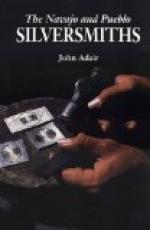[Illustration: Pl. XIX. Objects in silver.]
The chasing was the next process. To make the round indentations on the handle, one smith held the article on the anvil while the other applied the point of the shank of a file—previously rounded—and struck the file with a hammer. The other figures were made with the sharpened point of a file, pushed forward with a zigzag motion of the hand. When the chasing was done the silver was blanched by the process before referred to, being occasionally taken from the boiling solution of almogen to be rubbed with ashes and sand. For about five hours both of the smiths worked together on this powder-charger; subsequently, for about three hours’ more, there was only one man engaged on it; so that, in all, thirteen hours labor was spent in constructing it. Of this time, about ten hours were consumed in forging, about one and one-half hours in filing and rubbing, and about the same time in ornamenting and cleaning.
In making the hollow silver beads they did not melt the silver, but beat out a Mexican dollar until it was of the proper tenuity—frequently annealing it in the forge as the work advanced. When the plate was ready they carefully described on it, with an awl, a figure (which, by courtesy, we will call a circle) that they conjectured would include a disk large enough to make half a bead of the required size. The disk was then cut out with scissors, trimmed, and used as a pattern to cut other circular pieces by. One of the smiths proceeded to cut out the rest of the planchets, while his partner formed them into hollow hemispheres with his matrix and die. He did not put them at once into the cavity from which they were to get their final shape, but first worked them a little in one or more larger cavities, so as to bring them gradually to the desired form. Next the hemispheres were leveled at the edges by a method already described, and subsequently perforated by holding them, convex surface downwards, on a piece of wood, and driving through them the shank of a file with blows of a hammer. By this means of boring, a neck was left projecting from the hole, which was not filed off until the soldering was done. The hemispheres were now strung or, I may say, spitted on a stout wire in pairs forming globes. The wire or spit referred to was bent at one end and supplied with a washer to keep the heads from slipping off, and all the pieces being pressed closely together were secured in position by many wraps of finer wire at the other end of the spit. The mixture of borax, saliva, and silver was next applied to the seams of all the beads; they were put into the fire and all soldered at one operation. When taken from the fire they were finished by filing, polishing and blanching.




